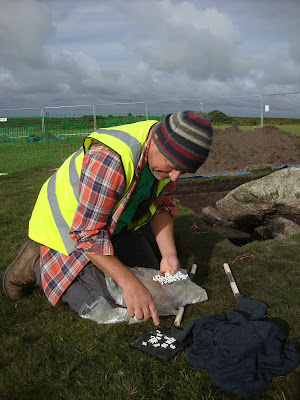Reading The Hurlers – Dig Week – Day 6 Open Day
An action packed day on Bodmin moor at the Dig Site, with
hundreds of visitors taking a look in the trenches to see the results of the
week long archaeological dig, and join in the many activities through the day.
Experts were on hand all day answering questions and
discussing theories of Archaeology and Geology, while many of the
trenches were being dug and recorded by the hard working team of diggers. Archaeologists from Cornwall Archaeology Unit continued to map, measure and record whilst also talking visitors through the dig site trenches.
Emma: "A huge thank you to all those who took part in both
the Dig and the Open Day, it would not have been the successful event it was
without everybody’s efforts."
Throughout the day Brian Sheen and his team from the
Roseland Observatory held drop-in workshops which explored the
astro-archaeology of The Hurlers and surrounding area. They explained some of
the theories of the stone alignments in The Hurlers complex, in addition to
casting their expert eye over the freshly exposed megaliths at the dig site.
Iain Rowe guided a small army of keen walkers across the
moors on the Beyond the Horizon guided walk, taking in key monuments which
cannot be seen direct from The Hurlers, but are part of the wider historical
landscape.
Towards the end of the day, and with a huge amount of excitement
a Socket Hole was discovered at the base of the large stone lying in Trench F. This stones geological make up already informed us that it had been brought to
the area (as have several of the large
stones in the dig area) and a Neolithic arrow head was discovered beneath the
side of the stone in Trench F. With the socket hole located we might surmise
this stone was indeed a standing stone megalith, and alignments have been
suggested to Solstice sun positions.
Did we uncover a fourth circle or are the stones part of a more complicated monument? It is still early days to fully understand and the evidence collection is ongoing, the area is a complicated historic landscape and we continue to read the hurlers for more information.
James: We’ve had a brilliant week on RTH and we’d like to
thank all the volunteers for all their hard work and dedication. Following
painstaking cleaning and excavation around the stones we are confident that at least
one of them was once a standing stone. This stone, Trench F, is where the
arrowhead was found.
Reading The Hurlers - Digger Teams debrief at the end of the dig week. - Spherical Image - RICOH THETA














